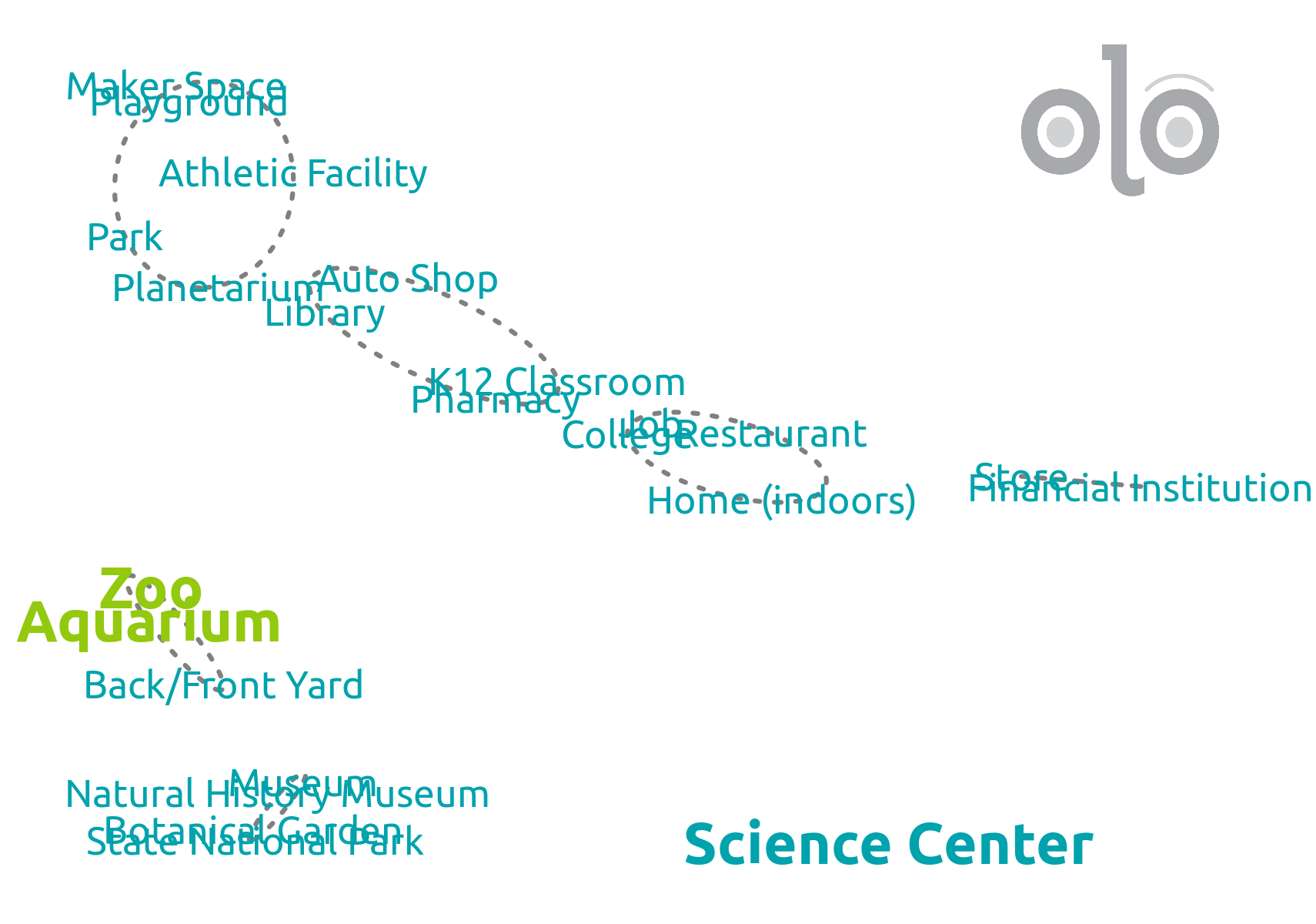How to Tap into STEM Learning in Any Setting
Research reveals different and sometimes unexpected places where people encounter STEM learning, highlights education opportunities for informal learning centers
Key Findings
Recently, Knology published a paper that explored public perceptions of the STEM learning ecology, defined as the broad range of spaces and opportunities where people encounter STEM concepts. The results of this nationwide survey show that adults think of the STEM ecology as not only the typical learning environments, but also other settings that can provide opportunities for STEM learning. The traditional settings include schools and classrooms, after-school programs, science centers, zoos and aquariums, botanical gardens. The less formal settings include the home, a backyard, or on the playground. STEM learning also occurs in places with entirely unrelated purposes such as in grocery stores, restaurants, and financial institutions.
Knology researchers surveyed over 1,400 US residents in an online panel for this study. Building on previous research, they looked at how frequently participants reported learning about STEM topics in science centers, natural history museums, botanical gardens, back- and front-yards, as well as at zoos and aquariums. Unsurprisingly, people most frequently said they learned about STEM concepts at science centers. But the team also looked for commonalities between the different learning environments based on the responses from study participants. We expected that some environments would naturally pair together in people’s minds. For example, zoos and aquariums might cluster with botanical gardens and national parks given their shared focus on ecological systems.
But our analysis revealed some unexpected groupings. Specifically, zoos and aquariums clustered most closely with back- and front-yards in people’s minds. The data suggests that the connective tissue is that people see these spaces as places to learn about and observe animal behavior. This emphasis on animal behavior might be why zoos and aquariums did not cluster with botanical gardens and national parks.

This visualization shows the results of a cluster analysis, demonstrating which settings are related to each other when people think of STEM learning. Note - The coordinates for Science Center fall outside of this plot, and have been adjusted closer for easier viewing
Besides animal behavior, respondents frequently reported learning about species names and reproductive behaviors at zoos. To a lesser extent, they learned about ecosystems, conservation, climate change, and sustainability. In addition to animal behavior, people frequently reported learning about water quality, species names, and reproduction. To a lesser extent, they reported learning about sustainability, ecosystems, and conservation.
Let’s Put It to Work
For Informal Learning Centers & Educators: The findings point to opportunities that informal learning centers could take advantage of to help people learn STEM concepts. Our analysis suggests that there is a much broader base of applied areas that informal learning centers could use to talk about STEM concepts. For example, educators at zoos and aquariums could talk about the STEM concepts that underlie their conservation activities. Furthemore, informal learning centers could build on people’s existing (and expansive) knowledge. For instance, since people already associate learning about animals with zoos and aquariums, professionals in these facilities could explicitly connect animal behavior to other STEM concepts, like the engineering involved in the life support systems in these facilities. Lastly, since science centers seem to be the gold standard for STEM learning, other informal learning centers could consider complementing their educational programming with some of the same approaches used in such settings.
For Marketing & Communications Professionals: The study suggests that audiences for any type of institution will embrace STEM-focused content, whether they are visitors or people who participate in other types of communications, such as social media. There are many opportunities to explore STEM stories underlying the work of any type of institution. For instance, a botanic garden could showcase the story of growing a certain tree species in a controlled climate. A history museum could create publications about the process of engineering a tool that was used during a historical time period. Lastly, an aquarium could create video of the computations involved in feeding its animal residents. Furthemore, institutions can relate content to aspects of people’s daily lives, such as common objects in the home or grocery store.
For Remote Learning: There are also opportunities for informal learning centers to provide fun learning experiences featuring STEM concepts that are accessible to audiences online, particularly in cases where in-person visits are not possible. This could include, for example, videos that show what goes on behind-the-scenes at a zoo or aquarium before guests arrive. Or videos that provide updates about how animals or objects are cared for in emergency situations. Institutions could also provide supplemental curriculum with these videos that target students K-12 and their teachers, adults, and animal care professions.
About this Study
This paper was published in the International Journal of Science Education, Part B. This study was conducted under the auspices of Why Zoos and Aquariums Matter (WZAM), a long-term research initiative designed to understand how zoos and aquariums contribute to society in the United States. The current WZAM research, called STEM Matters: Investigating the Confluence of Visitor and Institutional Agendas, is supported by National Science Foundation (award #DRK-1612729 and #DRK-1612699). Read more about the WZAM initiative here. You can also read some additional research on the STEM learning ecology here.